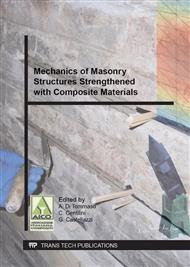[1]
U. Meier, Strengthening of structures using carbon fibre/epoxy composites, Constr Build Mater 9/6 (1995) 341-351.
Google Scholar
[2]
C. Bakis, L.C. Bank, V. Brown, E. Cosenza, J.F. Davalos J.J. Lesko, A. Machida, S.H. Rizkalla, T.C. Triantafillou, Fiber-reinforced polymer composites for construction - State-of-the-Art review, J Compos Constr 6/2 (2002) 73-87.
DOI: 10.1061/(asce)1090-0268(2002)6:2(73)
Google Scholar
[3]
T. Triantafillou, Strengthening of masonry structures using epoxy-bonded FRP laminates, J Compos Constr 2/2 (1998) 96-104.
DOI: 10.1061/(asce)1090-0268(1998)2:2(96)
Google Scholar
[4]
N. G. Shrive, The use of fibre reinforced polymers to improve seismic resistance of masonry, Constr Build Mater 20 (2006) 269-277.
DOI: 10.1016/j.conbuildmat.2005.08.030
Google Scholar
[5]
T.C. Triantafillou, C.G. Papanicolaou, Textile Reinforced Mortars (TRM) versus Fiber Reinforced Polymers (FRP) as Strengthening Materials of Concrete Structures, Proc. of the 7th Int. Symp. on Fiber Reinforced Polymer Reinforcement for Reinforced Concrete Structures - FRPRCS-7, Kansas City, USA, November 6-10, (2005).
DOI: 10.14359/14827
Google Scholar
[6]
A. D'Ambrisi, L. Feo, F. Focacci, Experimental analysis on bond between PBO-FRCM strengthening materials and concrete, Compos Part B-Eng 44/1 (2013) 524-532.
DOI: 10.1016/j.compositesb.2012.03.011
Google Scholar
[7]
C.G. Papanicolaou, T.C. Triantafillou, K. Karlos, M. Papathanasiou, Textile-reinforced mortar (TRM) versus FRP as strengthening material of URM walls: in-plane cyclic loading. Mater Struct 40/10 (2007) 1081-1097.
DOI: 10.1617/s11527-006-9207-8
Google Scholar
[8]
C.G. Papanicolaou, T.C. Triantafillou, M. Papathanasiou, K. Karlos, Textile reinforced mortar (TRM) versus FRP as strengthening material of URM walls: out-of-plane cyclic loading. Mater Struct 41/1 (2008) 143-157.
DOI: 10.1617/s11527-007-9226-0
Google Scholar
[9]
M.R. Valluzzi, F. da Porto, E. Garbin, M. Panizza, Out-of-plane strengthening of infill masonry walls with composites materials, Proc. 12th Canadian Masonry Symposium – CMS2013, Vancouver (Canada), June 2-5 (2013).
DOI: 10.1617/s11527-014-0384-6
Google Scholar
[10]
L. Garmendia, P. Larrinaga, D. García, I. Marcos, Textile-Reinforced Mortar as Strengthening Material for Masonry Arches. Int J Archit Herit, 8/5 (2014) 627-648.
DOI: 10.1080/15583058.2012.704480
Google Scholar
[11]
C. Menna, D. Asprone, C. Ferone, F. Colangelo, A. Balsamo, A. Prota, R. Cioffi, G. Manfredi, Use of geopolymers for composite external reinforcement of RC members, Compos Part B-Eng 45/1 (2013) 1667-1676.
DOI: 10.1016/j.compositesb.2012.09.019
Google Scholar
[12]
S. Tamburini, M. Favaro, A. Magro, E. Garbin, M. Panizza, F. Nardon, M.R. Valluzzi, Geopolymers as strengthening materials for Built Heritage. In: Proc. of Built Heritage 2013: Monitoring Conservation Management, Milan (Italy), November 18-20 (2013).
Google Scholar
[13]
E. Garbin, M. Panizza, M.R. Valluzzi, F. Nardon, S. Tamburini, M. Favaro, A. Magro, Characterization of Fibre Reinforced Geopolymers as structural strengthening material for brick masonry, Proc. 9th Int. Masonry Conference - IMC9, Guimarães (Portugal), July 7-9 (2014).
DOI: 10.23967/sahc.2021.110
Google Scholar
[14]
X. Huang, V. Birman, A. Nanni, G. Tunis, Properties and potential for application of steel reinforced polymer and steel reinforced grout composites, Compos Part B-Eng 36/1 (2005) 73-82.
DOI: 10.1016/s1359-8368(03)00080-5
Google Scholar
[15]
F. Ceroni, M. Pecce, Cracking behaviour of RC beams externally strengthened with emerging materials, Constr Build Mater 21/4 (2007) 736-745.
DOI: 10.1016/j.conbuildmat.2006.06.013
Google Scholar
[16]
A. Borri, P. Casadei, G. Castori, J. Hammond, Strengthening of brick masonry arches with externally bonded steel reinforced composites, J Compos Constr 13/6 (2009) 468-475.
DOI: 10.1061/(asce)cc.1943-5614.0000030
Google Scholar
[17]
P. Girardello, Rinforzo di volte in muratura con materiali compositi innovativi, Ph.D. Thesis, University of Padova, Italy (2013). In Italian.
Google Scholar
[18]
A. Khalifa, T. Alkhrdaji, A. Nanni, S. Lansburg, Anchorage of surface mounted FRP reinforcement, Concrete International: Design and Construction, 21/10 (1999) 49-54.
Google Scholar
[19]
F. Ceroni, M. Pecce, S. Matthys, L. Taerwe, Debonding strength and anchorage devices for reinforced concrete elements strengthened with FRP sheets, Compos Part B-Eng 39/3 (2008) 429-441.
DOI: 10.1016/j.compositesb.2007.05.002
Google Scholar
[20]
H.W. Zhang, S.T. Smith, Influence of FRP anchor fan configuration and dowel angle on anchoring FRP plates, Compos Part B-Eng 43/8 (2013) 3516-3527.
DOI: 10.1016/j.compositesb.2011.11.072
Google Scholar
[21]
S.V. Grelle, L.H. Sneed, Review of anchorage systems for externally bonded FRP laminates. Int. J. of Concrete Structures and Materials 7/1 (2013) 17-33.
DOI: 10.1007/s40069-013-0029-0
Google Scholar
[22]
R. Kalfat, R. Al-Mahaidi, S.T. Smith, Anchorage devices used to improve the performance of reinforced concrete beams retrofitted with FRP composites: State-of-the-art review, J Compos Constr 17/1 (2013) 14-33.
DOI: 10.1061/(asce)cc.1943-5614.0000276
Google Scholar
[23]
ACI 440. 2R-08, Guide for the design and construction of externally bonded FRP systems for strengthening concrete structures, American Concrete Institute (2008).
DOI: 10.14359/51700867
Google Scholar
[24]
CNR DT-200, Guide for the Design and Construction of Externally Bonded FRP Systems for Strengthening Existing Structures, Italian National Research Council (2004).
Google Scholar
[25]
ACI 440. 7R-10, Guide for the Design and Construction of Externally Bonded Fiber-Reinforced Polymer Systems for Strengthening Unreinforced Masonry Structures, American Concrete Institute (2010).
DOI: 10.14359/51663675
Google Scholar
[26]
G. Baronio, L. Binda, F. Cantoni, P. Rocca, Outdoor models to assess the durability of masonry, Masonry International 6/2 (1992) 50-53.
Google Scholar
[27]
Guidelines for assessment and improvement of connections in buildings, Final Report D10. 2, New integrated knowledge based approaches to the protection of cultural heritage from earthquake-induced risk - NIKER, Contract FP7-ENV-2009-1 n. 244123 (2012).
Google Scholar


